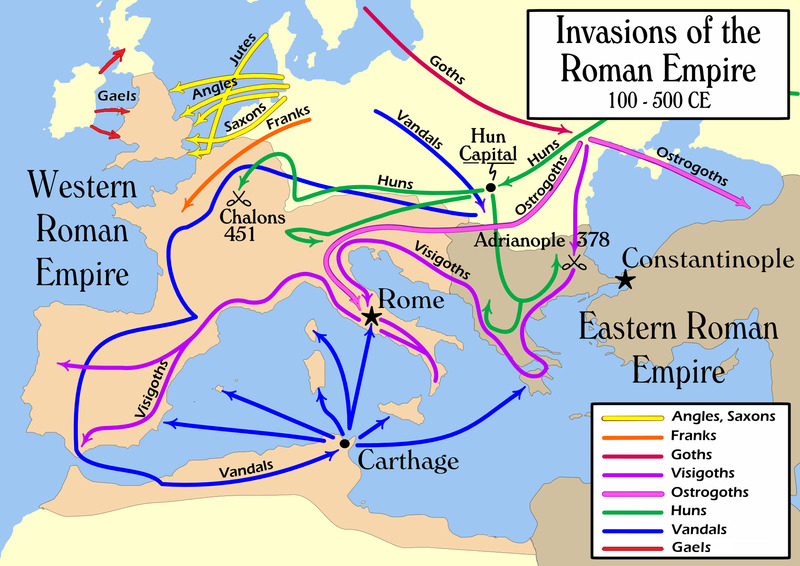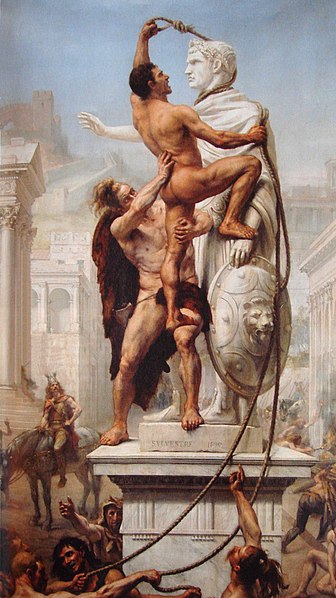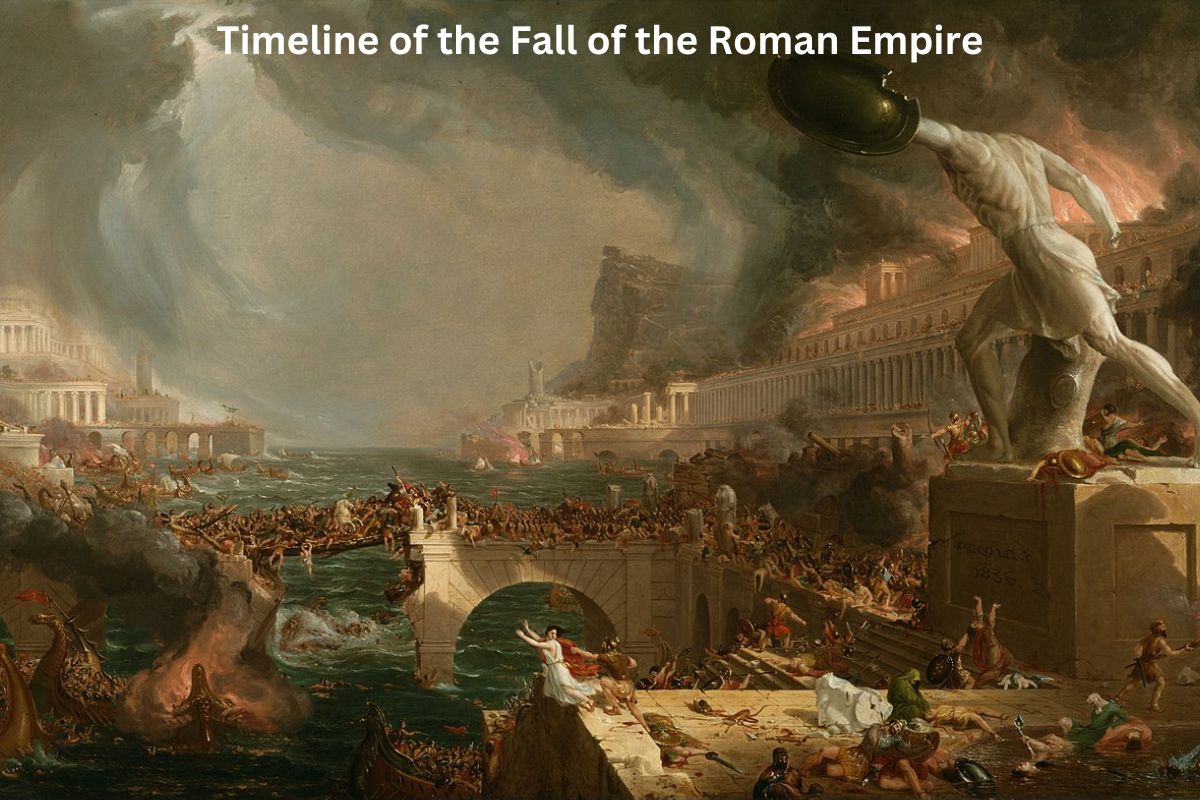The Fall of the Roman Empire was a gradual process occurring over centuries, beginning with the 3rd Century Crisis.
It involved economic instability, frequent changes of emperors, and invasions. Reforms were attempted, like Diocletian’s Tetrarchy and Constantine’s consolidation of the empire. Despite these efforts, internal decay and external threats persisted.
Significant events such as the sacks of Rome by the Visigoths in 410 AD and the Vandals in 455 AD weakened the empire.
The deposition of the last Western Roman Emperor, Romulus Augustus, by King Odoacer in 476 AD, is traditionally marked as the empire’s fall.
Meanwhile, the Eastern Roman Empire, or the Byzantine Empire, survived until 1453.
| Time Period | Key Events |
|---|---|
| 3rd Century Crisis (235-284) | Economic crisis, changes of emperors, plagues, internal unrest, invasions by Goths and Persians |
| Tetrarchy (284-305) | Diocletian divides the empire into eastern and western halves |
| Reign of Constantine (306-337) | Constantine legalizes Christianity, moves the capital to Byzantium |
| Fall of Western Empire (395-476) | Permanent division of empire after Theodosius I’s death, increasing pressure from Germanic tribes |
| Sack of Rome (410) | Rome sacked by the Visigoths led by King Alaric |
| Sack of Rome by Vandals (455) | Rome sacked by the Vandals |
| Deposition of Romulus Augustus (476) | Last Western Roman Emperor, Romulus Augustus, deposed by the Germanic King Odoacer |
The Fall of the Roman Empire Timeline
235-284 AD – 3rd Century Crisis – Economic instability, frequent changes of emperors, and invasions
This period is also known as the Imperial Crisis or the Crisis of the Third Century. It was marked by severe economic instability, frequent changes of emperors, military decline, and threats from outside groups.
The crisis began when Emperor Alexander Severus was murdered by his own troops, and this sparked nearly fifty years of chaos. During this period, the Roman Empire nearly collapsed under the combined pressures of invasion, civil war, plague, and economic depression.
It was a time of constant upheaval, with more than twenty different emperors ruling over this period, often achieving power through military force.

284-305 AD – Tetrarchy – Diocletian divides the empire into eastern and western halves
The system of the Tetrarchy was established by Emperor Diocletian. In an effort to bring stability, he decided to divide the vast Roman Empire into two parts: the Eastern and the Western Empires, each with its own emperor (an Augustus) and a junior emperor (a Caesar).
This system allowed for better administration and defense of the vast territories. Diocletian himself took the Eastern Empire, ruling from Nicomedia, and his colleague Maximian ruled the Western Empire from Milan.
However, this system also created new conflicts, especially during the transition of power, as it wasn’t clear how new emperors should be chosen.
306-337 AD – Reign of Constantine the Great – Legalizes Christianity, moves the capital to Byzantium
Constantine was one of the most significant emperors in Roman history. He reunited the Eastern and Western Roman Empires under his rule, and he is perhaps best known for legalizing Christianity with the Edict of Milan in 313 AD, ending the empire-wide persecution of Christians.
He also moved the capital of the empire from Rome to the city of Byzantium, later renamed Constantinople (modern-day Istanbul) in his honor.
This city was strategically located at the crossroads of Europe and Asia, which allowed for better defense and management of the eastern provinces.
During his reign, Constantine also undertook major administrative and military reforms to strengthen the empire.

395-476 AD – Fall of the Western Empire – Permanent division of empire after Theodosius I’s death, increasing pressure from Germanic tribes
When Emperor Theodosius I died in 395 AD, his two sons inherited the empire, with Honorius receiving the West and Arcadius the East. This effectively made the division between the Eastern and Western Roman Empires permanent.
The Western Roman Empire, weaker and more unstable than its Eastern counterpart, faced mounting pressures. It struggled with internal problems such as economic decay, political instability, and societal decline.
Additionally, the threat from Germanic tribes along the borders increased. Numerous tribes, including the Visigoths, Vandals, and Ostrogoths, continually invaded the Western Roman Empire’s territories.

410 AD – Sack of Rome by the Visigoths
The Visigoths, led by their King Alaric, sacked Rome in 410 AD. The Visigoths initially had been allies of Rome and were trained and equipped by the Romans, but due to various disputes and failed negotiations, they revolted.
The sack of Rome was a massive psychological blow to the Roman Empire as it was the first time in 800 years that Rome had fallen to a foreign enemy, and it marked a symbolic decline of Roman power and prestige.
455 AD – Sack of Rome by the Vandals
After the Visigoths, another Germanic tribe, the Vandals, sacked Rome in 455 AD. This event further undermined the standing of the Western Roman Empire.
The Vandals, under their King Genseric, not only sacked the city but also looted it for two weeks.
This sack was much more destructive than the earlier Visigothic one, causing significant physical damage to the city and the theft of a vast amount of its treasures.
476 AD – Deposition of Romulus Augustus – The last Western Roman Emperor is deposed by the Germanic King Odoacer
Romulus Augustus, the last emperor of the Western Roman Empire, was deposed by the Germanic King Odoacer in 476 AD. Odoacer was a mercenary leader in the Roman imperial army when he launched a rebellion and deposed the young emperor.
Romulus Augustus’s deposition is traditionally marked as the end of the Western Roman Empire. After deposing Romulus, Odoacer did not take the title of Emperor but instead proclaimed himself the King of Italy, further marking the fall of the Roman Empire.
